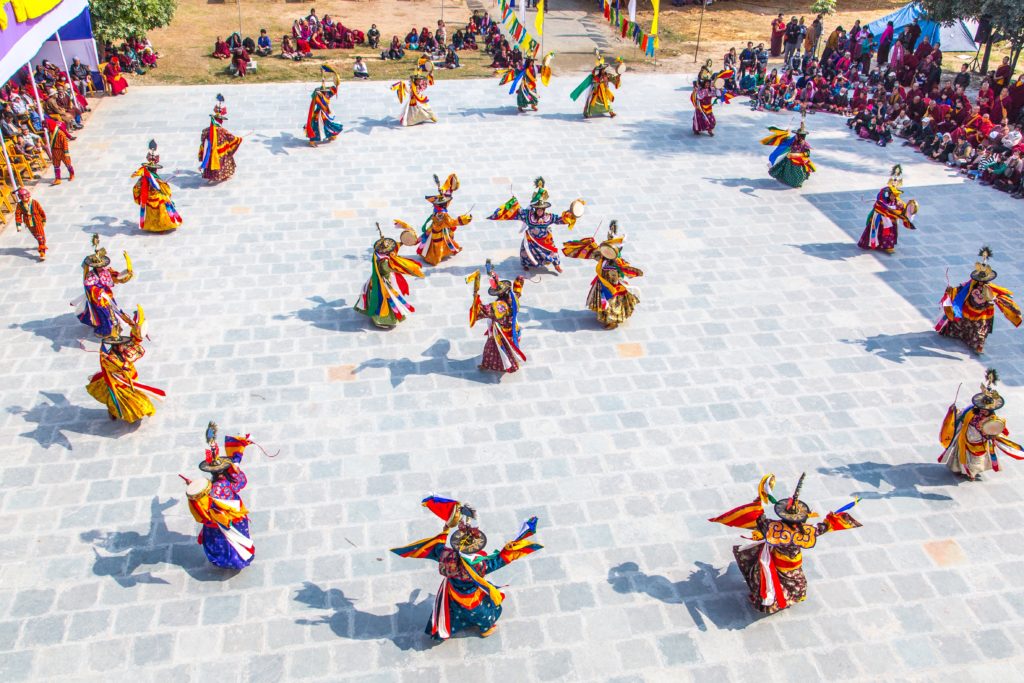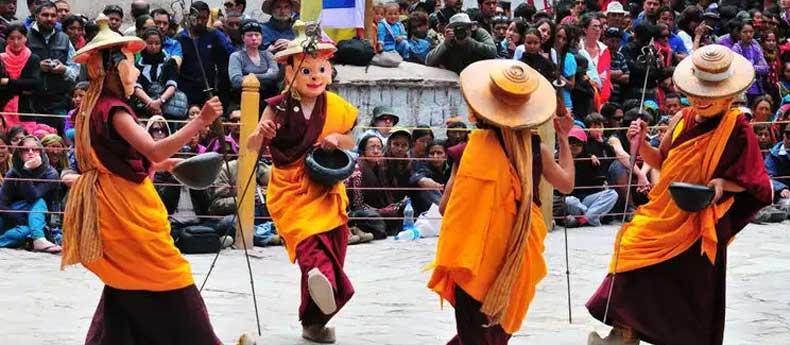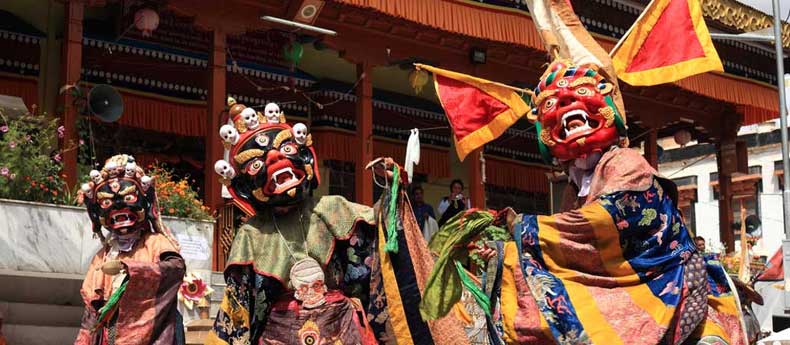The celebrations are in full swing as Ladakh marks the Ladakhi New Year with the Losar Festival. Over the course of the Buddhist year, there are numerous celebrations. Many commemorate significant moments of Buddha’s life or occasions in Buddhist history. Everywhere, Buddhists rejoice over others. They attend pujas and share discourses on the Buddha’s teaching. The ancient cultural legacy is perpetuated in Ladakh. There, Tantrayans Buddhism is practiced as a way of life, making it unique in the entire world. One such occasion is the Losar. Losar itself means ‘New Year’, Lo refers to Year and Sar refers to New. The Losar festival in Ladakh is celebrated to promote general well-being and to usher in the New Year with joy, optimism, and goodness triumphing over evil, negativity, and sadness. The idea is based on the pleasing of spirits and gods to ensure that people would be happy in the coming year. The Ladakhi or Tibetan New Year is commemorated at the Losar festival, which dates back to the fifteenth century. Although it is claimed to endure for z15 days, the first 3 days are the most momentous. Also, it has a different location (different monasteries in Ladakh) and dates each year as per the Lunar Calendar which is, on the first day of the 11th month of the Tibetan calI India, Nepal, Tibet, Sikkim, and Bhutan are the main countries that celebrate Losar, the Tibetan New Year Bhutan. Apart from Losar, the other popular festivals of Ladakh are Phyang Tsedup Festival, Dosmoche Festival, Hemis Festival. The best place to witness the celebrations of Losar are- Leh-Ladakh, Sikkim, Arunachal Pradesh, Darjeeling, and Himachal Pradesh. This Buddhist festival in Leh takes place on any of the dates between the 8th and 30th of December, around the time of the winter solstice. For the year 2022, it starts from December 24.
SIGNIFICANCE OF THE FESTIVAL
The Buddhist community celebrates “Losar” to mark the beginning of a new year. The Losar festival, which ushers in the New Year, is regarded as the most significant celebration in the Ladakh/Tibet region. The Ladakhi Buddhists offer a religious tribute to their gods at home shrines or in Gompas during this occasion. This festival includes a variety of traditional performances, ancient rituals, and cultural events. In Ladakh, during this month, one can observe a variety of activities such as- a good stage combat between the good and the wicked, shouting while advancing through the audience with burning fire torches, dancing ibex deer, conflicts between kings and ministers, and much more. A celebration supper with family and friends, loud music, Jabro (a dance form), and unbridled happiness are all represented. People go to see family and friends during the course of these two weeks of the festival. When devotees also travel to monasteries to give tributes and seek blessings. Ladakhis of all religions enthusiastically attend and celebrate this event. It is the intrusiveness of the Ladakhi people for the celebration of Buddhist New Year, similar to the enthusiasm witnessed in European countries for The Christmas and New Year celebrations and Diwali celebrations in India.

HISTORY OF LOSAR
The Losar celebration has its roots in Tibet’s pre-Buddhist Bon period. People sacrifice a large amount of incense during this event in order to appease the local gods and spirits. This ritual was changed into an annual Buddhist celebration, which most likely got its start during the reign of Pude Gungyal, the ninth Tibetan ruler. A spiritual event was held yearly in the winter according to an ancient custom. The origin is also attached to an event when the oracles who, in the 17th century, persuaded Jamyang Namgyal, King of Ladakh, to postpone his invasion against the armies of Baltistan until the next year. He decided to move up the New Year’s celebrations by a month to address this issue. Since that time, it has become customary to observe Losar during the eleventh Tibetan calendar month. It is also the period when Ladakh’s harvesting season comes to an end.
ABOUT THE FESTIVAL

During the 15-day Losar celebration, people give their deities freshly prepared food, clean their homes thoroughly, and wear new garments. The first three days of the festival count for the biggest of the celebrations. The community works hard to make several preparations well in advance of the most anticipated festival’s date. For the performances throughout the festivities, careful planning and appropriate rehearsals begin in advance. To fend off any bad omens from life, well-being, and numerous preparations, people begin cleaning their homes and throwing out old and useless items. An extravagant offering known as Lama Losar is made, and there are colorful and vibrant decorations all over.
Monks from the Namgyal monastery present religious offerings to Goddess Palden Lhamo, who is revered as the supreme leader of the protectors of Dharma, on the day of the festival beginning very early in the morning. As the monks of the monastery chant an invocation for Palden Lhamo, every spectator engages in the ceremony under the Dalai Lama’s direction and offers prayers.
Day 1 belongs to Mistooh. It is prepared each morning. Mistooh is essentially a good luck charm for the New Year (including Brangyas made of Sattu). They exchange Losoma Tashis and begin the morning rituals. On this day, both Buddhist and customary rites are performed. They travel to their fort in the afternoon to pray, and in the evening, the entire town gathers on the roof of the monastery to see a performance of their traditional dance (Kayang).
On the second day, known as King’s Losar, a gathering is conducted inside the Hall of Excellence of Nirvana and Samsara. It entails performing religious ceremonies. People pay visit to local monasteries and bring gifts for the monks. They all assemble at their old monastery on the second day of Losar to perform the customary dance. Snowflakes serve as the sky’s blessings to them this time. For me, the loveliest moment is when they dance in the snow. At night, you can witness the fireworks by bursting crackers and burning the wooden sticks, which are also set off to frighten away any evil spirits that may be hiding around. The dignitaries are welcomed and greeted by the government. Moreover, Chinese, Nepalese, Bhutanese, Indian, Mongolian, and other nationalities are represented at the festivities.

Beginning on the third day, people worship the gods by waking up early, dressing newly, and serving offerings to them. The monks and locals begin to celebrate and join in the festivities. On this day, families gather for a feast to eat Kapse (a type of cake), sattuwith rice, Buddhist Tea and Chaang (local alcoholic drink).
Traditions or living expressions that have been passed down from our ancestors to our descendants are considered to be part of our Intangible Cultural Heritage. Examples include oral traditions, performing arts, social customs, rituals, festivals, and knowledge and practices relating to nature and the cosmos. Even though it is vulnerable, Intangible Cultural Heritage play a crucial role in preserving cultural variety in the face of accelerating globalization. Understanding other societies’ intangible cultural legacies facilitates cross-cultural communication and fosters respect for diverse cultural practices. It was in 2018; The Museology Department of National Museum Institute of Delhi had released a research-based academic documentary film based on the Ladakh Losar festival, titled ‘Losar- The New Beginning’. Later, this documentary got selected for the 9th Dada Saheb Phalke Film Festival 2019. We therefore aspire that the Losar Festival should also be added to UNESCO’s list of India’s intangible cultural heritage.
Got to know many things from your Article.
Thank you for sharing with us this useful information!!!